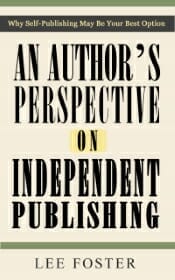By Lee Foster
 In Part 1 of my article, Book Publishing: Are You Keeping Up? we discussed:
In Part 1 of my article, Book Publishing: Are You Keeping Up? we discussed:
- How Traditional Publishing Worked (and Sometimes Still Works)
- Why Independent Publishing─Also Known as Self-Publishing─Arose
- Why Independent Publishing May Be Your Most Viable Option Now and in the Future
- Your Print-on-Demand Book
- Your Ebook Distribution
as based on the 2019 update of my book on publishing, An Author’s Perspective on Independent Publishing: Why Self-Publishing May Be Your Best Option.
Here is a main trend and some key practical adjustments to keep in mind from each chapter 6-10.
6. Your Book Content as a Website/Blog, Funded Partly by Advertising
How consumers may want to get your book’s content is changing in many ways. Many consumers may wish to access your book content in something other than a “book.” They might want to view your book on a website. They might well be willing to endure ads to get your content. You might earn more from ads around your content on a website than from actual sales of your book.
Moreover, seeing the content on a website may stimulate the consumer to click on your Buy button and purchase your book. A landmark recent article in the Washington Post asserts that ad spending on websites now actually surpasses all ad spending on all print media and on TV combined. This sounds incredible, but it appears to be true. Could you get a small slice of that abundance from your book content on your website?
Some practical details are as follows. First, don’t assume your book is unsuitable for ads. If you write erotic fiction, possibly a fragrance manufacturer would like to be present. If you have historical novels set in Greece, the Road Scholars tour operator is sending folks that way, and you are in fact part of the engine creating their demand.
Explore what ads are available to you, starting with Google AdSense Ads. You can put three on a page in a WordPress structure. I have them on my www.fostertravel.com site. I’ve earned something from them every day since 2002. There have been days when I didn’t sell a book, but did earn cash income from ads.
7. Your Social Media Outreach
Some social media outreach will be helpful for your success as an author. This will be true whether you are traditionally published or self-published. But what social media structures would be best for you? And how are they changing?
Who would have guessed a couple of years ago that Google + would fail by 2019? Everything Google invests in is golden, correct? But Google misjudged the audience and its fickle behavior. For me, Facebook, plus Facebook groups, and now Instagram, provide the most engagement.
The practical steps on this matter begin with self-examination. What are you prepared to sustain, if anything, in social media? I am not about to tell you how to spend the precious hours of your life, but I can say you will sell more books with some social media outreach.
What do I do? I commit to one new or updated article for my website each week, usually published on Wednesday. Then I announce the post in my four social media:
I also post in six or more Facebook groups, depending on whether the subject is “travel” or “publishing.” The posting and the social media “announcement” takes a couple of hours.
Start small, and do something you can sustain. Your fans will come to expect your social media presence in the time interval you project. How often do you want to hear from all your “friends”? Maybe once a week is about right.
8. Your Book Marketing Strategy
How far will you reach in your book marketing effort and when should you say, enough is enough, and be satisfied?
Your name may not be Michele Obama, and you may not sell 3 million copies of your book. The point is to be smart and realistic, and use your valuable resources of time and cash wisely. Be open to possibilities which you may not have imagined.
Also, accept, as you lurch forward in your book marketing, that you may make some mistakes. I have made mistakes. For example, for my literary travel book Travels in an American Imagination, I invested $350 to send a notice about the book to a list of reviewers, who could then request a review copy. I was the publisher and the only source of the book. About 100 “reviewers” responded, so I sent them physical books, at a cost.
- Only about five wrote reviews.
- About 50 of the books were available 30 days after my send of the books from “sub-sellers” on Amazon. Some of the “sub-sellers” advertised that the book they were selling was “new.”
The behavior of these “reviewers” was disappointing. When this happens, just get over it and move on, wiser the next time.
The practical takeaways are: Invest your time and some money in acquiring knowledge. A little knowledge goes a long way.
I think Joel Friedlander has an immensely valuable ecosystem in these presentations on his The Book Designer website. You will find other leaders in the publishing sector who seem relevant to your needs. Joan Stewart and Jane Friedman are two others whom I follow.
Then examine your own dreams and with what markers you would declare success. Give it your best shot, using your valuable resources of time and cash wisely, and accept the results. Maybe you’ll be happy, and maybe you won’t.
9. Your Need for Quality Design in Independent Publishing
The quality of books published, both indie and traditional, keeps improving. And I believe Joel Friedlander and this website play a role.
We strive for stronger covers, better editing, and more professional interior design. Every author needs to arrange the best quality possible at the most affordable price, whether the provider lives in your neighborhood or overseas. The cover of my An Author’s Perspective on Independent Publishing cost me $15 on Fiverr.com. It would have been $5, but this was a rush job. On the other hand, Joel Friedlander himself designed, in 2013, the cover and interior of my Northern California Travel: The Best Options. I paid him top dollar, and it was a good investment.
From a practical perspective, each of us in our region gradually acquires a knowledge of the people who might help us with editing, covers, and interior design. Reach out to your regional indie publishing group and learn what your colleagues have done. This is a word-of-mouth referral business. The collective knowledge of your peers can be helpful.
For my last three books, I have used one of Joel’s two-way interior templates and cover templates. I tried to do as much as I could myself. But I also invested in getting Joel’s colleague, Tracy Atkins, to take a look at what I did and make suggestions.
My preferred path now is:
- Get a template.
- Do it yourself as much as you can.
- Then get an expert to look things over and make suggestions.
We all need quality books, but at affordable costs that retain the dignity of self-publishing as a profitable venture.
10. Your Book’s Possible Specialized Adaptations, Such as an Audiobook and Chinese Translation
I have dropped a word out of this final chapter title for the next update. Can you guess what that word is? It is the word “app.”
While audiobooks and Chinese translation remain valid possibilities, apps did not flourish. The public did not seem to want the added functionality that software could bring to what was basically an ebook.
I had three successful apps with Sutro Media in the glorious app years, about 2009-2013. There was a day when Apple saluted my San Francisco app and a thousand copies sold that day.
Audiobooks now appear to be on the rise, about 6% of the book market. And Joel has a toolkit on audiobooks with Becky Parker Geist. I had Becky do an audiobook on my travel literary book Travels in an American Imagination.
And, for you, what about translation into Chinese and the sale of your ebook/book in China? Travels in an American Imagination and my main travel guidebook, Northern California Travel: The Best Options, have been translated into Chinese. I am getting some sales of the ebook versions each month. The links show how Amazon sells the ebooks both in China and on my USA Amazon Author Page. My Chinese publisher will return to San Francisco in May. She hopes to have by then a print book version in Chinese of Northern California Travel.
Is your book suitable for an audiobook or for Chinese translation? Remember that many people are using their “down” time, such as when commuting, to listen to audiobooks.
After evaluating your book, the next big decision is whether to narrate it yourself or get a professional reader. I went the professional reader route. However, there is some charm and authenticity in reading the narration yourself, as the author. Ironically, your production cost may be higher to read the book yourself. That’s because the audiobook producer may need to put more hours in to coach you, as an “amateur,” and to clean up your recordings to make the book sound professional.
If you are interested in Chinese translation possibilities, my publisher is Fiberead. Look over their website, see what they are publishing now, and approach them through the structure on their website.
They found the translator, managed all costs, and pay me 30% of their revenue for the ebooks. Amazon.cn is the most prominent sellers of my ebooks in China, but there are several other vendors, which I see in my reports on the Fiberead website.
Final thoughts
In conclusion, please share with us your success or disappointment as you observe the book publishing scene evolve quickly. What’s happening with you, for better and for worse, as you struggle to keep up?
Photo: BigStockPhoto. Amazon links contain affiliate code.


